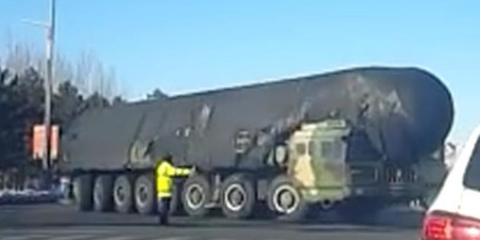Facts
| China/U.S. Designation | DongFeng-41 (DF-41)/CSS-X-20 |
| Missile Variants | N/A |
| Mobility and Role | Road-Mobile, Rail-Mobile, or Silo-Based/ Intercontinental Ballistic Missile (ICBM) |
| Designer/Producer | People’s Republic of China |
| Range | 12,000-15,000km |
| Warhead Type and Weight | Nuclear / 2,500 kg |
| MIRV and Yield | MIRV capability up to 10 war heads/ Single 1 MT or MIRV 20/90/150 KT |
| Guidance System/Accuracy | Inertial, GPS/100-500m CEP |
| Stages/Propellant | Three / Solid |
| IOC/Retirement | 2019 |
| Status/Number of Units | Operational / N/A (20+) |
Overview
The DF-41 has a range of 12,000-15,000 km[i] (able to target half to all of the continental U.S.), can carry multiple independently targetable reentry vehicles (MIRVs), and is rail-or road-mobile. The DF-41 is solid propelled and can carry a payload of up to 2500 kg.
The DF-41 missile is carried by Tian HTF5980 special wheeled chassis with 16×16 configuration. This vehicle has some degree of cross-country mobility and can travel over various terrain. Though it is mainly intended to be used on hard surface roads.[ii]
The DF-41 began development in July 1986 by the Academy of Launch Vehicle Technology, beginning life as Project No. 204 but was absorbed by the DF-31 project. [iii] Efforts continued in 1994, with deployment-ready missiles being sent to the PLARF in 2010. China began flight-tested it on July 2012, as well as a flight test in December 2014 with MIRVs and several launcher tests of the rail-mobile ICBM in December 2015.[iii] In December 2015, the missile was flight-tested for the fifth time. The latest flight test demonstrated the use of two MIRVs. The missile launch and dummy warheads were tracked by satellites to an impact range in western China.[iv] In April 2016 China successfully conducted 7th test of DF-41 with two dummy warheads near the South China Sea.[v] In November 2017, just two days before US President Trump’s visit to China, the DF-41 was tested in the Gobi desert.[vi]
The DF-41 likely entered limited production around 2019, with 18 launchers present at a training site in Inner Mongolia early that year. [vii] According to a 2022 DoD report, Chinese sources noted that two brigades existed that operated the DF-41 when it appeared in a 2019 parade, and as of November 2022, the PLA is continuing to build silos for DF-41 ICBMs.
Strategic Implications
The DF-41 poses several security challenges for the United States given its range, launch method, and payload. The DF-41 is able to target much of the continental U.S. and can carry up to 10 MIRVs with nuclear warheads. China is developing the DF-41 as a rail-mobile system. Rail-mobile systems make it harder for intelligence agencies to track the missiles movements as the trains may be disguised as passenger trains and can travel at high speeds. Rail-mobile platforms can also use tunnels for protection from satellites and as secure storage and loading facilities for the missiles, making it difficult to verify the number of rail-mobile systems and the number of missiles. The road-mobile versions are extremely survivable due their ability to stay protected inside of tunnel facilities and the be moved to nearby launch positions during a crisis. They also have the ability to operate independently in remote areas of China for increased difficulty to track and further bolstering survivability.
References
[i] http://www.nti.org/media/pdfs/design_characteristics_of_chinas_ballistic_cruise_missiles_3.pdf?_=1421279197.
[ii] http://www.military-today.com/missiles/df_41.htm
[iii] Missile Defense Project, “DF-41 (Dong Feng-41 / CSS-X-20),” Missile Threat, Center for Strategic and International Studies, August 12, 2016, last modified July 31, 2021, https://missilethreat.csis.org/missile/df-41/.
[iv] http://thediplomat.com/2016/01/china-tests-new-rail-mobile-missile-capable-of-hitting-all-of-us/.
[v] https://freebeacon.com/national-security/china-flight-tests-multi-warhead-missile/
[vi] https://freebeacon.com/national-security/china-confirms-multiple-warhead-missile-test-south-china-sea/
[viii] https://www.scmp.com/news/china/diplomacy-defence/article/2119201/did-china-test-missile-could-hit-any-target-us-two-days

